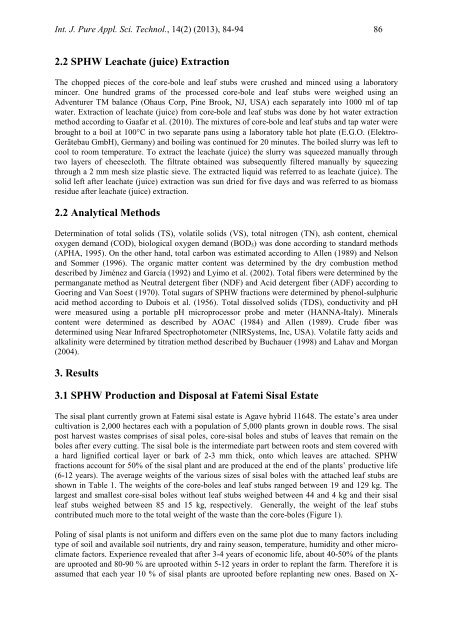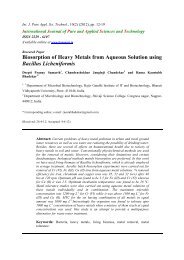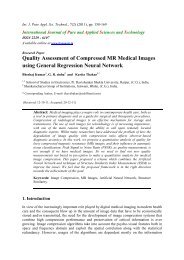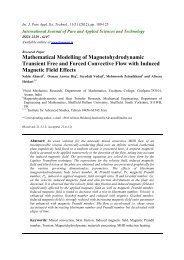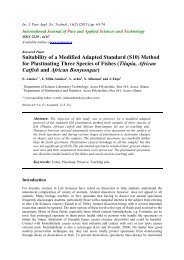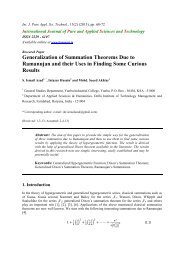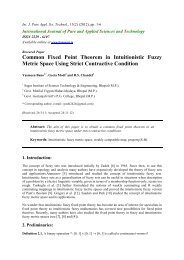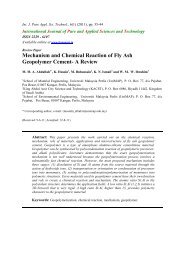Tanzania Sisal Industry: Auditing and Characterization of Sisal Post ...
Tanzania Sisal Industry: Auditing and Characterization of Sisal Post ...
Tanzania Sisal Industry: Auditing and Characterization of Sisal Post ...
- No tags were found...
Create successful ePaper yourself
Turn your PDF publications into a flip-book with our unique Google optimized e-Paper software.
Int. J. Pure Appl. Sci. Technol., 14(2) (2013), 84-94 86<br />
2.2 SPHW Leachate (juice) Extraction<br />
The chopped pieces <strong>of</strong> the core-bole <strong>and</strong> leaf stubs were crushed <strong>and</strong> minced using a laboratory<br />
mincer. One hundred grams <strong>of</strong> the processed core-bole <strong>and</strong> leaf stubs were weighed using an<br />
Adventurer TM balance (Ohaus Corp, Pine Brook, NJ, USA) each separately into 1000 ml <strong>of</strong> tap<br />
water. Extraction <strong>of</strong> leachate (juice) from core-bole <strong>and</strong> leaf stubs was done by hot water extraction<br />
method according to Gaafar et al. (2010). The mixtures <strong>of</strong> core-bole <strong>and</strong> leaf stubs <strong>and</strong> tap water were<br />
brought to a boil at 100°C in two separate pans using a laboratory table hot plate (E.G.O. (Elektro-<br />
Gerätebau GmbH), Germany) <strong>and</strong> boiling was continued for 20 minutes. The boiled slurry was left to<br />
cool to room temperature. To extract the leachate (juice) the slurry was squeezed manually through<br />
two layers <strong>of</strong> cheesecloth. The filtrate obtained was subsequently filtered manually by squeezing<br />
through a 2 mm mesh size plastic sieve. The extracted liquid was referred to as leachate (juice). The<br />
solid left after leachate (juice) extraction was sun dried for five days <strong>and</strong> was referred to as biomass<br />
residue after leachate (juice) extraction.<br />
2.2 Analytical Methods<br />
Determination <strong>of</strong> total solids (TS), volatile solids (VS), total nitrogen (TN), ash content, chemical<br />
oxygen dem<strong>and</strong> (COD), biological oxygen dem<strong>and</strong> (BOD 5 ) was done according to st<strong>and</strong>ard methods<br />
(APHA, 1995). On the other h<strong>and</strong>, total carbon was estimated according to Allen (1989) <strong>and</strong> Nelson<br />
<strong>and</strong> Sommer (1996). The organic matter content was determined by the dry combustion method<br />
described by Jiménez <strong>and</strong> García (1992) <strong>and</strong> Lyimo et al. (2002). Total fibers were determined by the<br />
permanganate method as Neutral detergent fiber (NDF) <strong>and</strong> Acid detergent fiber (ADF) according to<br />
Goering <strong>and</strong> Van Soest (1970). Total sugars <strong>of</strong> SPHW fractions were determined by phenol-sulphuric<br />
acid method according to Dubois et al. (1956). Total dissolved solids (TDS), conductivity <strong>and</strong> pH<br />
were measured using a portable pH microprocessor probe <strong>and</strong> meter (HANNA-Italy). Minerals<br />
content were determined as described by AOAC (1984) <strong>and</strong> Allen (1989). Crude fiber was<br />
determined using Near Infrared Spectrophotometer (NIRSystems, Inc, USA). Volatile fatty acids <strong>and</strong><br />
alkalinity were determined by titration method described by Buchauer (1998) <strong>and</strong> Lahav <strong>and</strong> Morgan<br />
(2004).<br />
3. Results<br />
3.1 SPHW Production <strong>and</strong> Disposal at Fatemi <strong>Sisal</strong> Estate<br />
The sisal plant currently grown at Fatemi sisal estate is Agave hybrid 11648. The estate’s area under<br />
cultivation is 2,000 hectares each with a population <strong>of</strong> 5,000 plants grown in double rows. The sisal<br />
post harvest wastes comprises <strong>of</strong> sisal poles, core-sisal boles <strong>and</strong> stubs <strong>of</strong> leaves that remain on the<br />
boles after every cutting. The sisal bole is the intermediate part between roots <strong>and</strong> stem covered with<br />
a hard lignified cortical layer or bark <strong>of</strong> 2-3 mm thick, onto which leaves are attached. SPHW<br />
fractions account for 50% <strong>of</strong> the sisal plant <strong>and</strong> are produced at the end <strong>of</strong> the plants’ productive life<br />
(6-12 years). The average weights <strong>of</strong> the various sizes <strong>of</strong> sisal boles with the attached leaf stubs are<br />
shown in Table 1. The weights <strong>of</strong> the core-boles <strong>and</strong> leaf stubs ranged between 19 <strong>and</strong> 129 kg. The<br />
largest <strong>and</strong> smallest core-sisal boles without leaf stubs weighed between 44 <strong>and</strong> 4 kg <strong>and</strong> their sisal<br />
leaf stubs weighed between 85 <strong>and</strong> 15 kg, respectively. Generally, the weight <strong>of</strong> the leaf stubs<br />
contributed much more to the total weight <strong>of</strong> the waste than the core-boles (Figure 1).<br />
Poling <strong>of</strong> sisal plants is not uniform <strong>and</strong> differs even on the same plot due to many factors including<br />
type <strong>of</strong> soil <strong>and</strong> available soil nutrients, dry <strong>and</strong> rainy season, temperature, humidity <strong>and</strong> other microclimate<br />
factors. Experience revealed that after 3-4 years <strong>of</strong> economic life, about 40-50% <strong>of</strong> the plants<br />
are uprooted <strong>and</strong> 80-90 % are uprooted within 5-12 years in order to replant the farm. Therefore it is<br />
assumed that each year 10 % <strong>of</strong> sisal plants are uprooted before replanting new ones. Based on X-


